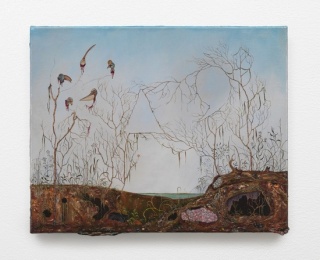I couldn’t write about one of the current Hauser and Wirth exhibitions in London, without writing about the other one (especially as I particularly enjoyed it). Anj Smith’s exhibition of paintings really do need to be seen to be appreciated.
 |
|
The Combatant Photo: Alex Delfanne |
Smith has commented that “running throughout all these ideas in some form or another, is a rejection of neat and easy certainties and an embrace of disintegrating or newly morphing thresholds” and has spoken about her interest in liminality. The Oxford Dictionary of Critical Theory defines liminality as “a ritual space or phase of transition in which a person is no longer what they were, but is not yet what they will be. The liminal is the in-between, the neither one thing nor the other.” In the exhibition, this not only seemed reflected by the fusion between animal, human and costume, but also the texture of the paintings themselves. The paintings oscillate between a sense of transparency, shininess, and thick, almost sculptural impasto. It is impossible to grasp the complexities of the painting on a computer screen, so I would highly recommend going to see the works in person.
 |
|
| Chorus, 2012 Oil on linen, Source: Hauser and Wirth website |
The Hauser and Wirth website highlights the “gender ambiguity” in many of her portraits and Smith has referred to her interest in Judith Butler. She also lists her other influences as “Persian miniature painting, Bosch, Botticelli and the Netherlandish still-lifes, the Ballets Russes, Blake, Dadd and Darger, Bataille, the streets, certain subcultures, night life, high fashion, Currin, Cooke and Peyton…Yuskavage, Sasnal, Bujinowski, lepidoptery, botany, costume, armor and weaponry.”
The title of the exhibition, “Phosphor on the Palms,” was inspired by Wallace Stevens’ poem ‘Fabliau of Florida’. Smith has said that “the poem seems to embrace a similar sense of liminality, in this case in the portrait of a beach scene where the clouds and surf scum appear indistinguishable.” This made me very curious about the poem, so I thought I would include it here:
Fabliau of Florida
Barque of phosphor
On the palmy beach,
Move outward into heaven,
Into the alabasters
And night blues.
Foam and cloud are one.
Sultry moon-monster
Are dissolving.
Fill your black hull
With white moonlight.
There will never be an end
To this droning of the surf.
I decided to use the word “poetic” in the title of this post because the paintings stimulate the imagination and are both incredibly tangible and evocative. Smith has commented on painting as language:
“Very loosely speaking, the flowering ‘phantoms’ of the show’s title relate to the way that language operates in a relentless process of evolution, with new meanings constantly springing from the death throes of their predecessors. The art historical context of painting now is dragged into this as much as any other language (a skull in a Dutch Golden age still-life now seems to signify McQueen rather than mortality. Not even that, thanks to the market rip-offs, perhaps the old sign for death has now just emptied out to solely indicate genericism).”
The exhibition runs until November 21st, so you can go and see for yourself! I’ll finish with a link to another poem, unrelated but which came to mind…
Nameless by William Montgomerie
Source of Fabliau of Florida: ‘Poetry’ (October 1919), at http://www.poetryfoundation.org/poetrymagazine/poem/3770.